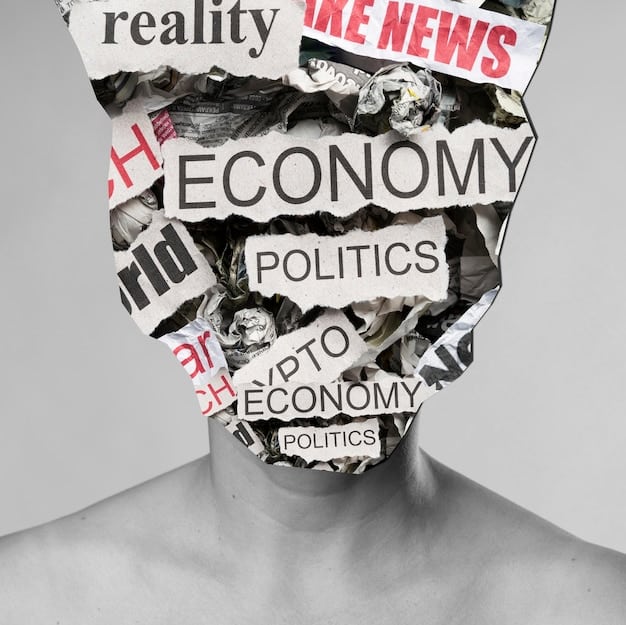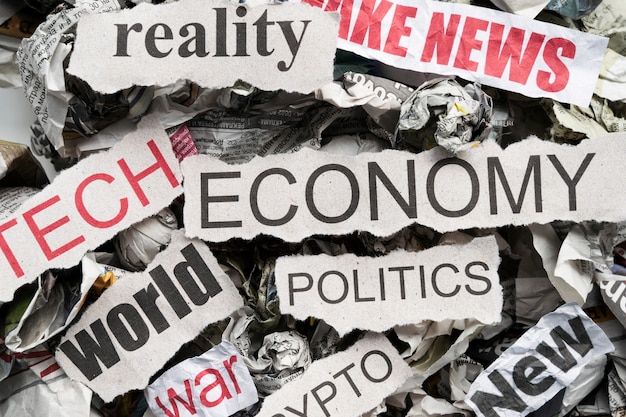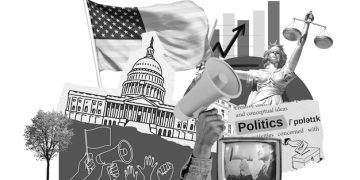Analyzing Economic News: Framing Effects in US Media

Anúncios
Analyzing the framing of economic issues in US news media involves examining how journalists select and present information, which can significantly influence public perception and understanding of economic events and policies.
Anúncios
The way economic issues are presented in the news significantly shapes public opinion and understanding. Analyzing the framing of economic issues in US news media is crucial to understanding how these narratives are constructed and their potential impact on society, policy decisions, and individual behavior.
Introduction to Economic Framing in US News Media
Economic news plays a vital role in informing citizens, and understanding how it’s framed is essential. The news media’s choices in language, emphasis, and context can significantly influence how the public perceives economic realities, impacting opinions and behaviors.
Anúncios
Framing isn’t merely about spinning information; it’s about crafting narratives. By analyzing these frames, we can better understand the subtle, yet powerful, ways that news shapes our economic perspectives.

The Power of Framing: Shaping Perceptions
Framing influences perception by highlighting certain aspects of an issue while downplaying others. This selection process affects how audiences interpret information, impacting their attitudes and behaviors.
Media framing is not inherently negative; it is a function of communication. However, understanding its effects is necessary for discerning and informed citizenship.
Defining Media Framing
Media framing involves selecting and emphasizing certain facets of an issue to promote a specific interpretation. This occurs through word choice, images, and narrative structure.
Psychological Impact of Framing
Different frames can evoke distinct emotional responses, cognitive associations, and motivate different actions. Studies show that negatively framed economic news can lead to anxiety and pessimism.
- Highlighting positive aspects of economic data can foster optimism and encourage spending.
- Focusing on job losses can increase economic anxiety and reduce consumer confidence.
- Framing economic policies as beneficial to specific groups can affect their levels of support.
Ultimately, media framing shapes how economic events are understood and acted upon, underscoring the importance of critical media consumption.
Key Elements of Economic News Framing
Framing operates through several key elements that impact how economic news is received. These elements, including selection, emphasis, and presentation, construct the stories we see.
Understanding the mechanics of framing helps us dissect the narratives we encounter, aiding us in forming our own informed perspectives.
Selection and Omission
News outlets choose which economic stories to cover and which to leave out. This affects the audience’s sense of what’s important, skewing their understanding of the overall economic climate.
Emphasis and Tone
The tone adopted when reporting economic news—whether optimistic, pessimistic, or neutral—affects audience sentiment. Certain terms and phrases can sway opinions.
Presentation and Context
How economic information is presented (e.g., through charts, expert opinions, or personal stories) impacts its accessibility and persuasiveness.
- The use of technical jargon can alienate the average reader, while relatable stories can foster empathy.
- Visual aids can simplify complex data, but they’re also prone to manipulation or misinterpretation.
- The context in which news is presented affects how it is integrated into existing beliefs.
By recognizing these elements, individuals can become more conscious of framing effects in media narratives, encouraging a more nuanced understanding.
Common Framing Techniques in US Economic News
Specific framing techniques are frequently used to characterize economic realities in US news. These methods influence how the public understands and responds to economic issues.
Awareness of these persistent patterns empowers the audience to critically assess media and challenge prevailing narratives.
Causation Framing
Attributing economic outcomes to specific causes can shape perceptions of responsibility and influence policy preferences. Blaming government policies for economic downturns can prompt calls for policy reversal.
Human Interest Framing
Focusing on individual stories to illustrate economic trends can evoke strong emotions and enhance engagement. Stories of families struggling during recessions can create empathy.

Conflict Framing
Highlighting disagreements among economists or policymakers can create drama and deepen audience investment. However, this can also oversimplify complex issues.
- Presenting economic debates as binary conflicts can mislead the audience about the range of possible solutions.
- Focusing on political clashes can overshadow the technical aspects of economic analysis.
- Conflict framing can erode trust in experts if they appear overly partisan.
Understanding common framing techniques boosts awareness of prevalent biases and encourages individuals to seek diverse perspectives for comprehensive insights.
Case Studies: Examples of Framing Economic Issues
Analyzing case studies reveals how framing influences public understanding of specific economic events. Examining narratives around significant issues showcases how information is molded.
These examples serve as key lessons, enhancing our aptitude for spotting and interpreting diverse viewpoints in news coverage.
The 2008 Financial Crisis
Media coverage of the crisis often framed it as a result of individual greed or institutional failures. This promoted a sense of outrage and demand for accountability.
Tax Reform Debates
Tax cut proposals are framed differently by various news outlets, some emphasizing benefits for businesses, others spotlighting impacts on low-income families. Such framing influences public support or opposition.
Trade Policy Discussions
Trade agreements are sometimes framed positively, emphasizing economic growth and job creation, while others highlight job losses and environmental concerns. This can influence trade policy perception.
Studying these cases provides a deeper insight into how media framing shapes perceptions of crucial economic events, encouraging better understanding of news impacts.
The Role of Bias in Economic News Framing
Bias plays a significant role in how economic news is presented, impacting narratives and potentially undermining objectivity. Recognizing bias is key to understanding media’s influence.
Understanding how bias can be incorporated within journalistic practices develops a more cautious understanding and interpretation of news coverage.
Political Bias
News outlets often align with particular political ideologies, shaping how they frame economic policies and events. Conservative media often highlights lower tax benefits, while liberal media focuses on income inequality.
Corporate Bias
Media organizations owned by large corporations may frame economic news in ways that favor those corporations. This bias can lead to incomplete or misleading coverage, favoring corporate interests.
- Influence on what stories are covered.
- Tone and emphasis in reporting.
- Selection of experts quoted.
Nationalist Bias
News coverage may prioritize national economic interests over global ones, framing trade policies in terms of their impact on American jobs. This promotes national interests but can limit global perspectives.
Recognizing these biases allows for a more critical evaluation, enabling individuals to seek multiple sources, compare reports, and form opinions based on broad, representative information.
Promoting Critical Media Consumption
Encouraging critical media consumption is essential for a well-informed public. This involves actively evaluating the information presented and recognizing the potential for framing effects.
By adopting critical strategies, people can navigate complex economic news landscapes with enhanced awareness and discernment.
Seeking Diverse Sources
Reading news from multiple sources helps counter the effects of framing by exposing individuals to different perspectives. Diversifying news consumption promotes a more balanced understanding.
Fact-Checking Information
Verifying claims made in economic news is crucial for avoiding misinformation. Fact-checking enhances the reliability of insights and enhances decision-making.
Understanding Statistical Context
Interpreting economic data requires understanding statistical methodologies, limitations, and potential biases. Contextual awareness is vital for properly evaluating economic information.
By promoting these critical practices, individuals can develop a nuanced understanding of economic issues, strengthening their capacity for informed decision-making and broader societal participation.
| Key Topic | Brief Description |
|---|---|
| 📊 Framing Effects | How news presentation shapes public perception of economics. |
| 📰 Elements of Framing | Selection, emphasis, and context influence media narratives. |
| ⚖️ Bias in News | Political, corporate, and nationalist biases skew reportage. |
| 🧐 Consume Critically | Seek diverse sources and fact-check economic information. |
Frequently Asked Questions
▼
Media framing involves selecting and emphasizing specific aspects of economic issues, influencing public interpretation and opinion, affecting how society perceives economic news.
▼
Framing analysis helps to detect possible biases and nuances in news reporting, promoting essential evaluation and understanding how various narrative perspectives impact society.
▼
Biases, such as political or corporate interests, affect what stories are covered, the tone used, and the experts quoted, biasing overall reporting and influencing society.
▼
Common techniques include causation framing, which attributes economic results to specific reasons, and human-interest framing, focusing on effects on individuals, influencing reader view.
▼
Seeking multiple sources, verifying facts, and understanding context assists people with forming balanced views and recognizing possible frames, promoting better understanding of nuances influencing society.
Conclusion
In conclusion, the analysis of economic news framing in US media highlights the critical role that media plays in shaping public opinion. Understanding framing techniques, recognizing biases, and promoting critical media consumption are essential for fostering an informed and discerning public.





